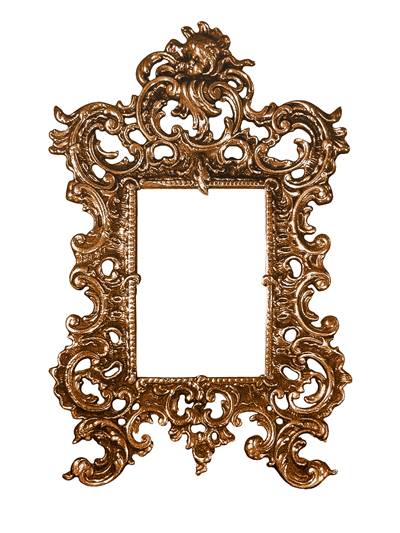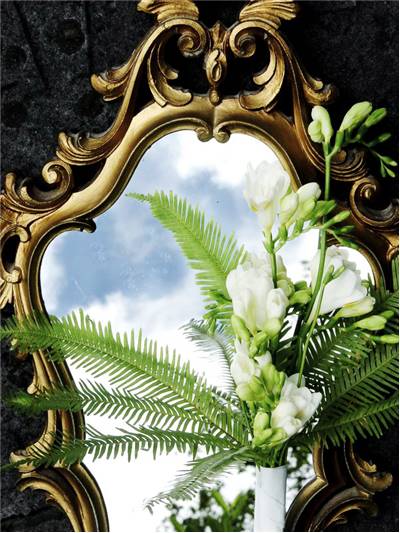The History of Mirrors
A mirror is flat or curved surface usually produced of glass that has had a reflective coating applied to it. Mirrors are also used in technology and they are an important component in scientific instruments such as telescopes, industrial machinery, cameras and lasers.
People probably first started to look at their reflections in pools of water, streams and rivers which were the first mirrors. The earliest man made mirrors were from polished stone and mirrors made form black volcanic glass obsidian. Some examples of this kind of mirrors have been found in Turkey dating back at least 6000 years. The Ancient Egyptians used polished copper to produce mirrors, and often the round face of the mirror would be embellished with ornamentation. The Ancient Mesopotamians also produced polished metal mirrors and mirrors made from polished stone were known in Central and South America from about 2000 BC. In China mirrors began to be made from metal alloys, a mixture of tin and copper called speculum metal that could be highly polished to made a reflective surface as well as mirrors made of polished bronze. Metal alloys or precious metals mirrors were very valuable items in ancient times only affordable to the very wealthy.
It is believed that mirrors made of metal-backed glass this type of mirror was first produced in Lebanon in the first century AD and the Romans made crude mirrors from blown glass with lead backings.
Mirror History and Origins of Mirrors
The ancient Egyptians, Romans and Greeks were quite fond of mirrors and often manufactured mirrors from polished copper and bronze. Glass mirrors were first produced during the third century A.D., and were quite common in Egypt, Gaul, Germany and Asia. The invention of glassblowing method during the 14th century led to the discovery of convex mirrors, which increased the popularity of glass mirrors...
Making Mirrors
A major mirror component is glass. Because glass is a poor reflector, it must be coated in order to make a mirror. The most appropriate materials for making metallic coatings are silver, gold, and chrome.
Facts about Mirrors
The concepts of the soul are often associated with mirrors, which results in a wealth of superstition surrounding mirrors. For instance, breaking a mirror causes seven years of bad luck because the soul which shatters with the broken mirror regenerates every seven years (old Roman legend). Mirrors also have a strong connection to spirits. Mirrors are covered when some dies, because according to some superstitions, a mirror can trap the soul of the person who dies.
Mirror Interesting Facts
During the period of the Renaissance in Europe, mirrors were made by a method of coating glass with a tin and mercury amalgam. In the sixteenth century, Venice became the centre of manufacture for such mirrors. A factory for manufacturing mirrors called Saint-Gobain was established in France, but mirrors were still expensive luxuries and only the very rich owned it.
In 1835 Justus von Liebig, a German chemist, developed the silvered-glass mirror where a thin layer of metallic silver is put onto glass by the chemical reduction of silver nitrate. The invention of this process enabled to mirrors being manufactured on a much larger scale, and for the first time in history ordinary people could buy a mirror. Present-day mirrors are more frequently produced by depositing aluminum by vacuum directly onto the glass.
There are many superstitions including mirrors. Breaking a mirror to this day is said to bring bad luck that lasts seven years. This curse is believed to go back to Roman times when they thought that it took seven years for a soul to renew itself. One of the ways that you could avoid the bad luck was to bury all pieces of broken mirror very deeply in the ground. It is also said that a mirror in the house falling from a wall is a sign that someone was going to die. It used to be common practice to cover up all mirrors in the house when somebody in a house died. It was believed that this prevent the soul of the deceased being trapped in one of the mirrors by the devil.
A BRIEF HISTORY OF BATHS AND SHOWERS
By Tim Lambert
Baths and Showers in the Ancient World
The Egyptians are known for their cleanliness (they bathed frequently) and they used many cosmetics. Meanwhile in Babylon before 2,000 BC a form of soap was made. The Greeks knew that diet and exercise and keeping clean were important for health. The Greeks even invented a form of shower, which sprayed bathers with water.
Most Greeks washed in a bowl on a pedestal called a louterion though the rich sometimes had bathrooms. People rubbed themselves with olive oil then rubbed it off with a tool called a strigil.
The Romans also knew that dirt encourages disease and they appreciated the importance of cleanliness. They built aqueducts to bring clean water into towns. In Roman towns an important building was the public baths. In Roman times people went to the baths not just to get clean but also to socialize. Roman Baths consisted of a frigidarium or cold room, a Tepidarium or warm room and a caldarium or hot room. You usually finished with a dip in a cold pool. To clean themselves Romans rubbed their skin with oil and scraped it off with a tool called a strigil. (The Romans also made soap).
Roman women also used razors, pumice stone, tweezers and depilatory creams to remove unwanted body hair.
Baths in the Middle Ages
In the Middle Ages there were bathhouses in many towns were people could pay to have a bath. Furthermore in Northern Europe in the Middle Ages people took sweat baths.
In the 14th century Edward III installed a bathroom in the Palace of Westminster. Other people made do with wooden tubs in their bedrooms.
Furthermore in the Middle Ages there was an important soap making industry in England (although many people made their own soap at home). In the Middle Ages people used combs and tweezers. They also used toothpicks and mouthwashes.
In the Middle Ages in monasteries streams provided clean water. Dirty water was used to clear toilets, which were in a separate room. Monks also had a room called a laver where they washed their hands before meals.
Baths and Showers 1500-1800
Most Tudors cared about their appearance. People carried mirrors made of glass or steel. They also carried combs and used tweezers, ear scoops and bone manicure sets. In the Summer people sometimes had a bath in the local river. Sometimes they heated a cauldron of water and had a strip wash. Or they could have a 'dry wash' by rubbing themselves with clean linen.
In the 16th century bathrooms were very rare but Henry VIII had a bathroom in Hampton Court Palace. It had a simple boiler for hot water.
In the 17th century people used toothpicks but in the latter part of the century toothbrushes were introduced. (Toothbrushes came from China. They were first mentioned in 1498). People also made scented soaps. Then in 1767 Englishman William Feetham invented the first modern shower. However, in Britain showers did not become common until the late 20th century.
Baths and Showers in the 19th Century and 20th Century
In the mid 19th century middle class homes began to have bathrooms. Having a bath was also made much easier when Benjamin Waddy Maughan invented the gas water heater in 1868. The electric water heater was invented in 1889 by Edwin Ruud. Working class houses with bathrooms were first built around 1900 and in the 1920s council houses were built with bathrooms. However at that time bathrooms were still a luxury. As late as the early 1960s many homes in Britain did not have a bathroom.
From about 1800 portable metal bathtubs gradually replaced wooden ones and in the 19th century some people used hand-pumped showers. Paper towels were invented by Arthur Scott in 1907.
In the 19th century toothpaste was sold in jars until 1892 when Washington Sheffield invented the collapsible toothpaste tube. Meanwhile in 1888 the first modern deodorant was invented. It was called Mum.
The first safety razors for men were sold in 1901. Women first began to shave under their arms in the 1910s. The first razor for women was introduced in 1915.
In the 19th century most homes also had a scullery. In it was a 'copper', a metal container for heating water for washing clothes. The copper was filled with water and soap powder was added. To wash the clothes they were turned with a wooden tool called a dolly. Or you used a metal plunger with holes in it to push clothes up and down. Wet clothes were wrung through a device called a wringer or mangle to dry them. The clothes wringer or mangle was invented by Robert Tasker in 1850. The 'modern' clothes peg with a spring clamp was invented in by David M Smith in 1853.
Simple hand operated washing machines were invented in the 18th century. The first electric washing machine was made in 1907. In Britain washing machines first became common in the late 1950s and 1960s. Meanwhile, the electric clothes dryer was invented in 1935 by a man named J. Ross Moore. The first laundromat opened in Fort Worth, Texas in 1934. The first laundrette in Britain opened in 1949.
Joel Houghton invented the first dishwasher in 1850. However, it was not a success. Josephine Cochrane invented the first successful dishwasher in 1886. By 2009 36% of households in Britain had a dishwasher. Steel wool cleaning pads were invented in 1913.
Meanwhile soap was rationed in Britain from 1942 to 1950.

People used to wash their clothes with soap flakes. The first synthetic detergent was invented in Germany during the First World War. In the following decades detergents were gradually improved and became more common. Today washing is much easier than it was in the past.





0 comments: